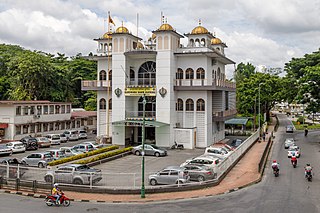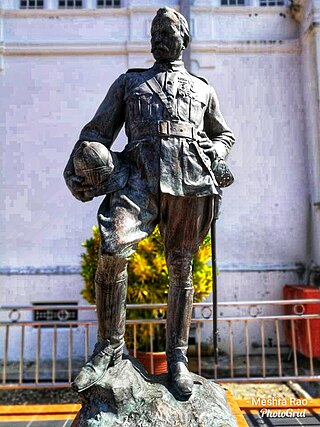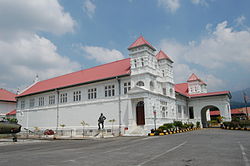
Perak is a state of Malaysia on the west coast of the Malay Peninsula. Perak has land borders with the Malaysian states of Kedah to the north, Penang to the northwest, Kelantan and Pahang to the east, and Selangor to the south. Thailand's Yala and Narathiwat provinces both lie to the northeast. Perak's capital city, Ipoh, was known historically for its tin-mining activities until the price of the metal dropped, severely affecting the state's economy. The royal capital remains Kuala Kangsar, where the palace of the Sultan of Perak is located. As of 2018, the state's population was 2,500,000. Perak has diverse tropical rainforests and an equatorial climate. The state's main mountain ranges are composed of the Titiwangsa, Bintang and Keledang Ranges, where all of them are part of the larger Tenasserim Hills system that connects Myanmar, Thailand and Malaysia.

The Federated Malay States was a federation of four protected states in the Malay Peninsula — Selangor, Perak, Negeri Sembilan and Pahang — established in 1895 by the British government, and which lasted until 1946. In that year they formed the Malayan Union together with two of the former Straits Settlements,, and the Unfederated Malay States. Two years later, the union became the Federation of Malaya, which achieved independence in 1957, and finally Malaysia in 1963 with the inclusion of North Borneo, Sarawak and Singapore.

James Wheeler Woodford Birch, commonly known as J. W. W. Birch was a British colonial official who was assassinated in the Malay state of Perak in 1875, an event that led to the outbreak of the Perak War and ultimately to the extension of British political influence over the Malay Peninsula.

The National Museum is a public museum in Kuala Lumpur, Malaysia dedicated to Malaysian art, culture, and history. Located on Jalan Damansara close to Perdana Lake Gardens across KL Sentral station. Its façade comprises elements from both traditional Malay and modern features. It was inaugurated on 31 August 1963, and it serves as a repository of Malaysia's cultural and historical heritage.

Taiping is a town located in Larut, Matang and Selama District, Perak, Malaysia. It is located approximately 48 km (30 mi) northwest of Ipoh, the capital of Perak, and 78 km (48 mi) southeast of George Town, Penang. With a population of 245,182, it is the second largest town in Perak after Ipoh, the state capital.

Sir Hugh Low, was a British colonial administrator and naturalist. After a long residence in various colonial roles in Labuan, he was appointed as British administrator in the Malay Peninsula where he made the first trials of Hevea rubber in the region. He is often considered the first successful British administrator in the region, whose methods became models for subsequent British colonial operation in the entire South East Asia Region.

Khoo Kay Kim was a Malaysian historian and academic of Chinese descent. He was honoured with Emeritus Professor title by the University of Malaya in 2001. In January 2011, Khoo was appointed Chancellor of KDU University College.

Kapitan China Chung Keng Quee was the founder and administrator of modern Taiping in Perak, Malaysia. Appointed "Capitan China" by the British in 1877, he was a millionaire philanthropist and known as an innovator in the mining of tin. He was involved in many other industries including farming, pawnbroking and logging. He was respected by both Chinese and European communities in the early colonial settlement. His survival in the chaotic era owes much to his standing as leader of the Hai San, a Chinese secret society in British Malaya during the time of the Larut Wars (1862–73), a position he is said to have held until early 1884, although in all probability he continued to remain a leading member. The old fort at Teluk Batu was built by him to safeguard the mine that he opened there.

Taiping Aerodrome is an aerodrome in Taiping, Larut, Matang and Selama, Perak, Malaysia. It is located at Jalan Muzaffar Shah formerly Creagh Road, Assam Kumbang and also called Tekah Airstrip. The airport was built in early 1929, this wooden structure aerodrome was the first airfield in the state of Perak and also in Peninsular Malaysia.

The Royal Malaysia Police Museum is a museum that showcases the history of the Royal Malaysia Police, located in Kuala Lumpur, Malaysia. The museum includes exhibits from the history of the Royal Malaysia Police since its origins under British colonial rule until the 1970s. It is open daily, except Monday, from 1000 to 1800 hours, and admission is free.

Taiping Hospital, formerly known as Yong Wah Hospital, is a district general hospital was one of the first hospitals established in Malaysia. Located at Jalan Taming Sari near the commercial town centre, it is one of the biggest hospitals in Malaysia and is the second biggest in the State of Perak. The hospital is strategically situated 80 km from Ipoh and 85 km from Penang and was able to serve the northern states of Malaysia.
The Taiping Clubs were sports and recreation clubs that existed in the city of Taiping, Malaysia, during the 1880s. At the time, the city saw significant growth in European as well as Chinese, Indian, Arab, and Indonesian communities, and thus the need for such clubs arose. The following is a non-exhaustive list of these establishments.

The first market built in Taiping was in 1884 and 1885. Due to the rapid growth of population in the town, there were more markets that mushroomed around the town to provide basic facilities to the folks. Below are the major markets that were constructed in 1884 until the late 1960s.
Treacher Methodist Girls' School is located at Museum Road off Walker Road in Taiping, Perak, Malaysia.

The Taiping railway station is a Malaysian train station located at and named after the town of Taiping, Perak.

The Kinta Valley is a conurbation in central Perak, Malaysia, surrounding and including the state capital Ipoh. Historically the Kinta Valley was very rich in tin, and their mines have been among the most productive in the world. The valley is formed by the Kinta River, a tributary of the Perak River, which flows between the Titiwangsa and Keledang Ranges.

Malaysian Sikhs are known to be the fourth largest Malaysian Indian ethnic group. It is estimated that there are around 100,000 Sikhs in Malaysia.

Lieutenant-Colonel Robert Sandilands Frowd Walker, also known as R. S. F. Walker, was a prominent figure in Malaya during the British colonial era in the late 19th century.

The statue of Robert Sandilands Frowd Walker CMG is situated outside Perak Museum, Jalan Taming Sari, Taiping, Perak, Malaysia.

Leonard Wray ISO, also known as Leonard Wray Jr., was a botanist and geologist who served as Director of Museums of the Federated Malay States.



















